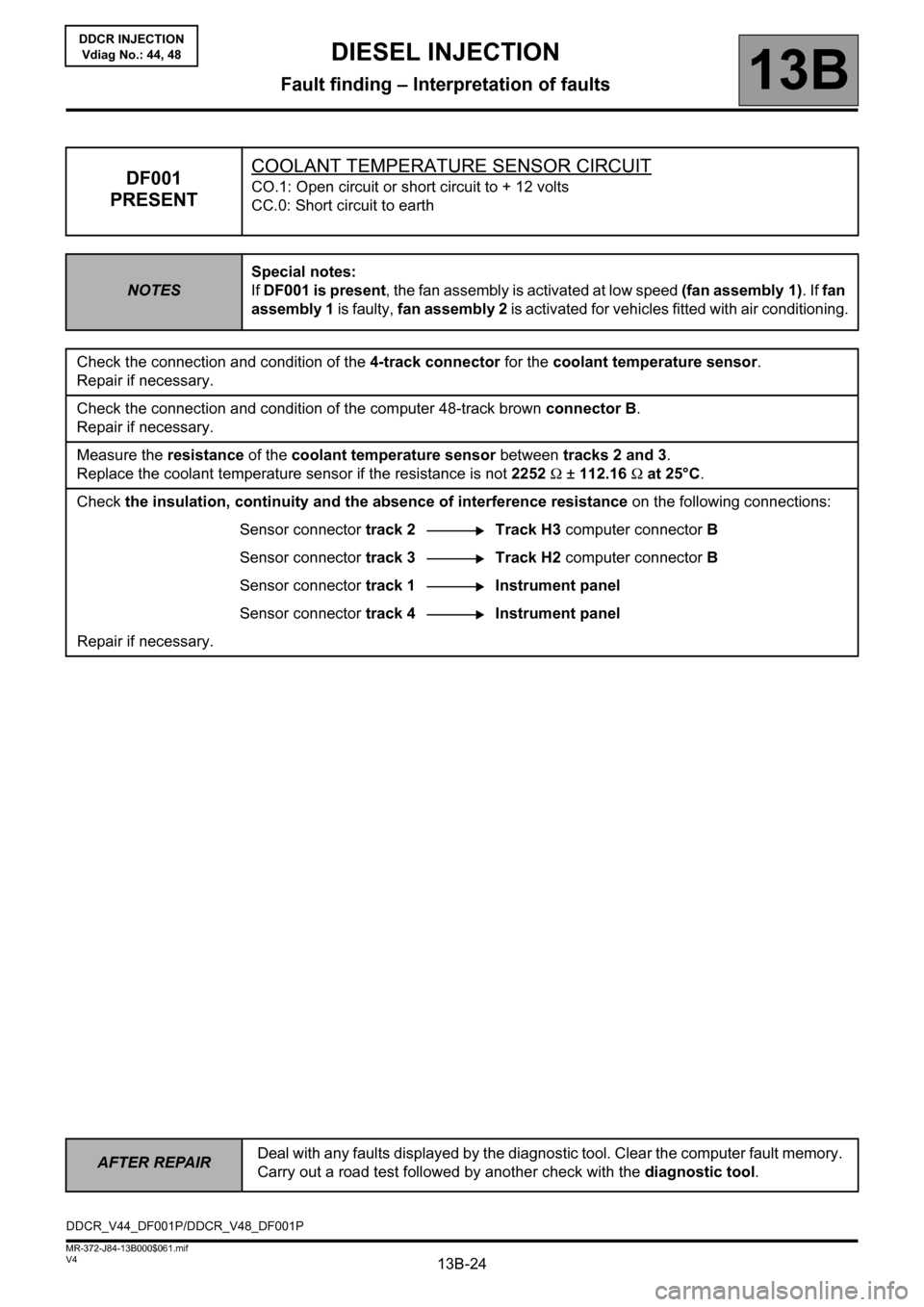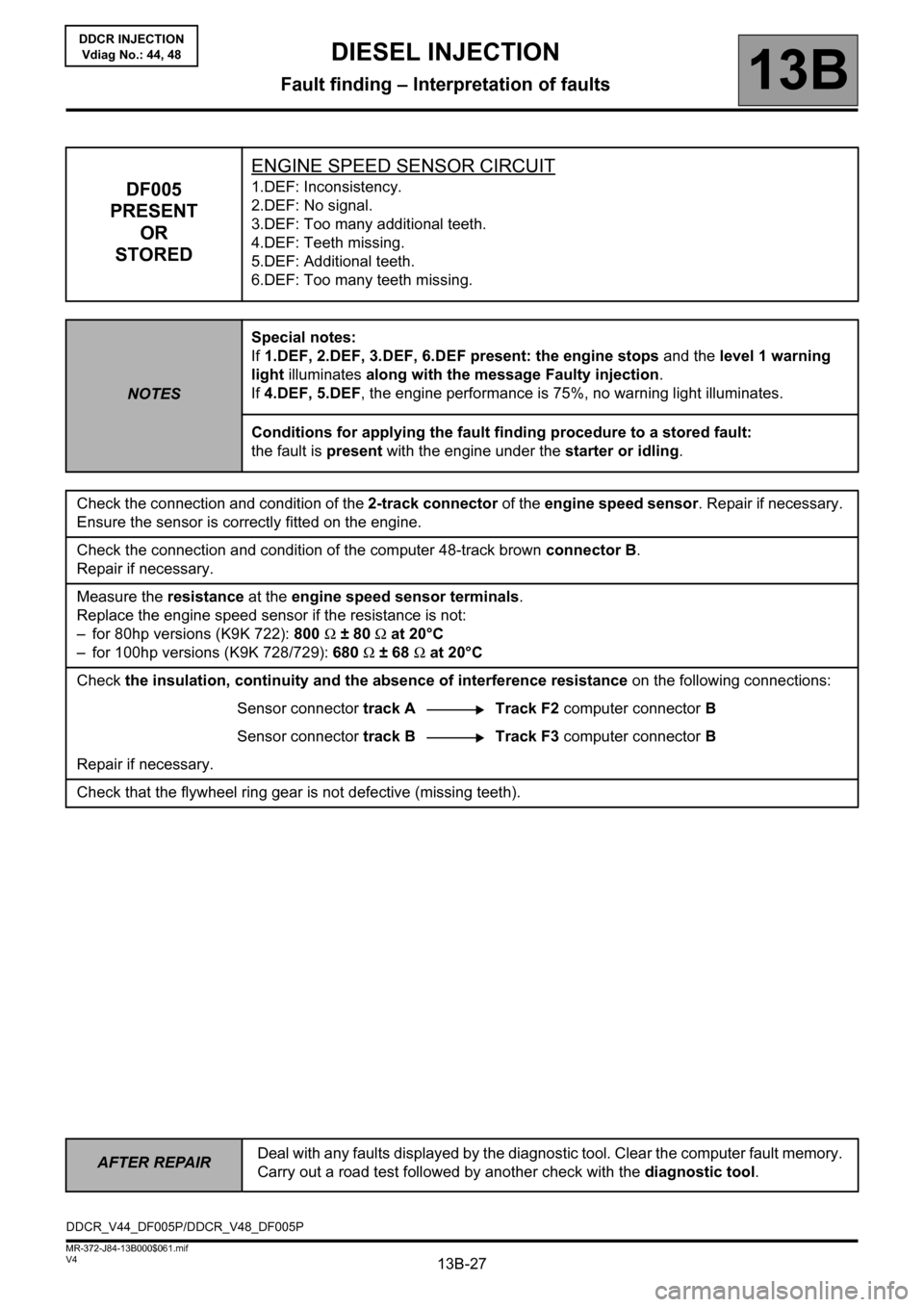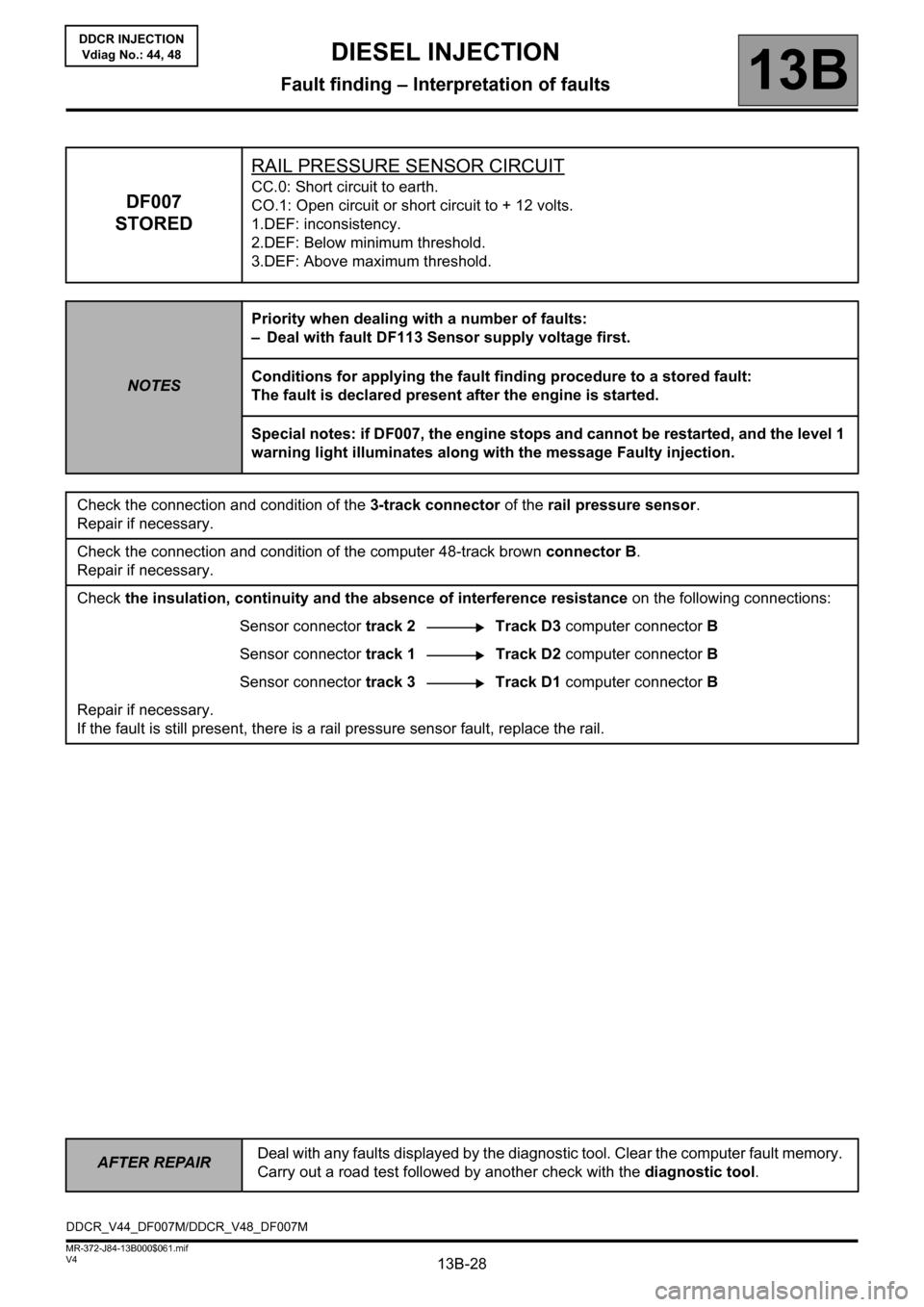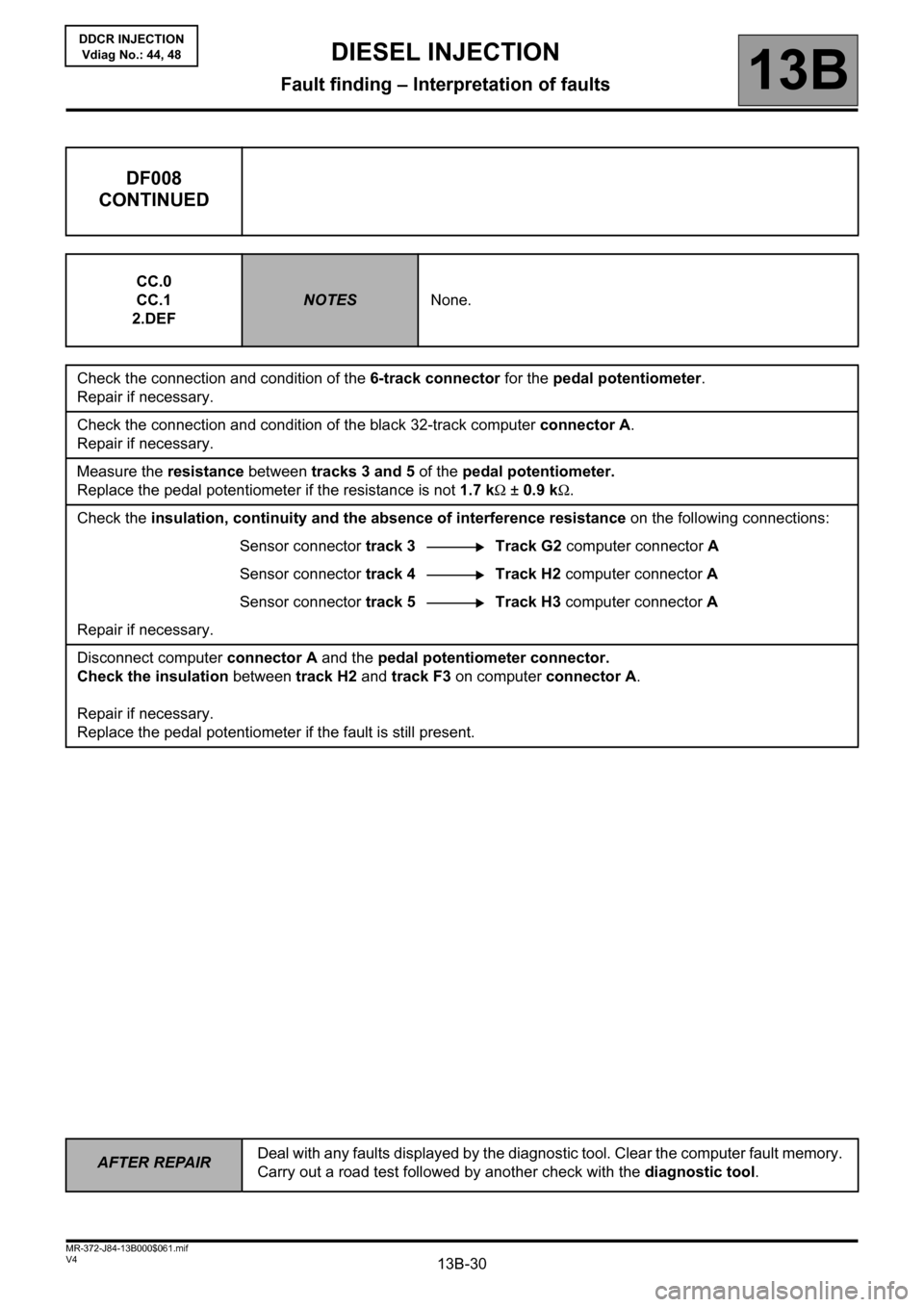abs RENAULT SCENIC 2011 J95 / 3.G Engine And Peripherals Workshop Manual
[x] Cancel search | Manufacturer: RENAULT, Model Year: 2011, Model line: SCENIC, Model: RENAULT SCENIC 2011 J95 / 3.GPages: 198, PDF Size: 0.85 MB
Page 5 of 198

13B-5V4 MR-372-J84-13B000$010.mif
DIESEL INJECTION
Fault finding – Introduction13B
DDCR INJECTION
Vdiag No.: 44, 48
4. FAULT FINDING PROCEDURE (continued)
Wiring check
Fault finding problems
Disconnecting the connectors and/or manipulating the wiring may temporarily clear the cause of a fault.
The electrical measurements of the voltage, resistance, and insulation are generally correct, especially if the fault is
not present when the measurements are being taken (stored fault).
Visual inspection
Look for damage under the bonnet and in the passenger compartment.
Carefully check the fuses, insulators and wiring harness routing.
Look for signs of oxidation.
Physical inspection
When handling the wiring, use the diagnostic tool to detect any change in the status of the fault from stored to
present.
Make sure that the connectors are firmly locked.
Apply light pressure to the connectors.
Twist the wiring harness.
If there is a change in status, try to locate the source of the fault.
Inspection of each component
Disconnect the connectors and check the appearance of the clips and tabs as well as their crimping (no crimping on
the insulation). Check that the clips and the tabs are correctly locked in the sockets.
Check that no clips or tabs have been dislodged during connection.
Check the clip contact pressure using an appropriate model of tab.
Resistance check
Check the continuity of entire lines, then section by section.
Look for a short circuit to earth, to + 12 V or with another wire.
If a fault is detected, repair or replace the wiring harness.
5. FAULT FINDING LOG
IMPORTANTIMPORTANT
Any fault on a complex system requires thorough fault finding with the appropriate tools.
The FAULT FINDING LOG, which should be completed during the procedure, enables you to
keep track of the procedure which is carried out. It is an essential document when consulting
the manufacturer.
IT IS THEREFORE COMPULSORY TO COMPLETE A FAULT FINDING LOG EVERY TIME A FAULT FINDING
PROCEDURE IS PERFORMED
Page 12 of 198

13B-12V4 MR-372-J84-13B000$020.mif
DIESEL INJECTION
Fault finding – System operation13B
DDCR INJECTION
Vdiag No.: 44, 48
Functions included
Air conditioning management assistance
For vehicles with air conditioning, the DDCR system can switch off the air conditioning under certain engine
operating conditions:
– when requested by the driver,
– when starting the engine,
– if the engine overheats (in order to reduce the power the engine has to supply),
– when the engine speed is kept at a very high level (to protect the compressor),
– during transition phases (e.g. under heavy acceleration when overtaking, anti-stalling and moving off strategies).
These conditions are only taken into account when they do not occur repeatedly, in order to prevent system
instabilities (erratic deactivations),
– when certain faults appear.
Cold loop air conditioning management
The air conditioning is the cold loop type and its management shared between several computers. The injection
computer is responsible for:
– managing demand for cold air according to the passenger compartment commands and the pressure value,
– determining the power absorbed by the compressor from the pressure,
– determining the fan unit commands according to vehicle speed and pressure.
The driver requests the air conditioning to be switched on by means of the ventilation selector coupled to a switch.
The cold air request is authorised or denied depending on the pressure measured. If this pressure is outside
the operating limits, the cold loop program is not activated.
Thermal regulation of the passenger compartment heating circuit
In a direct injection engine, fuel is injected directly into the combustion chamber. This leads to heat being lost
through the upper part of the engine and consequently, the cylinder head cooling circuit is smaller in size.
The effect of this is that the temperature of the coolant flowing through this circuit rises more slowly. However, this
coolant is also used by the passenger compartment heating system. In very cold conditions, it is therefore difficult to
achieve a comfortable passenger compartment temperature quickly.
To limit the time taken to warm up the system, air heating resistors, called RCHs, are fitted into the passenger
compartment heating circuit. The UCH decides whether the RCH are required, the UPC physically actuates
the RCH, and the injection computer determines whether to limit the power supplied to the RCH depending on
alternator charge, and also whether to disable them according to engine speed, load and vehicle speed. NOTE:
Fan unit actuation requests can be made by the injection computer, but these are sent on the CAN. These requests
depend on the air conditioning but also on the coolant temperature and vehicle speed.
Page 24 of 198

13B-24
AFTER REPAIRDeal with any faults displayed by the diagnostic tool. Clear the computer fault memory.
Carry out a road test followed by another check with the diagnostic tool.
V4 MR-372-J84-13B000$061.mif
13B
DDCR INJECTION
Vdiag No.: 44, 48
DF001
PRESENTCOOLANT TEMPERATURE SENSOR CIRCUITCO.1: Open circuit or short circuit to + 12 volts
CC.0: Short circuit to earth
NOTESSpecial notes:
If DF001 is present, the fan assembly is activated at low speed (fan assembly 1). If fan
assembly 1 is faulty, fan assembly 2 is activated for vehicles fitted with air conditioning.
Check the connection and condition of the 4-track connector for the coolant temperature sensor.
Repair if necessary.
Check the connection and condition of the computer 48-track brown connector B.
Repair if necessary.
Measure the resistance of the coolant temperature sensor between tracks 2 and 3.
Replace the coolant temperature sensor if the resistance is not 2252 Ω ± 112.16 Ω at 25°C.
Check the insulation, continuity and the absence of interference resistance on the following connections:
Sensor connector track 2 Track H3 computer connector B
Sensor connector track 3 Track H2 computer connector B
Sensor connector track 1 Instrument panel
Sensor connector track 4 Instrument panel
Repair if necessary.
DDCR_V44_DF001P/DDCR_V48_DF001P
DIESEL INJECTION
Fault finding – Interpretation of faults
Page 25 of 198

13B-25
AFTER REPAIRDeal with any faults displayed by the diagnostic tool. Clear the computer fault memory.
Carry out a road test followed by another check with the diagnostic tool.
V4 MR-372-J84-13B000$061.mif
DIESEL INJECTION
Fault finding – Interpretation of faults13B
DDCR INJECTION
Vdiag No.: 44, 48
DF002
PRESENTAIR TEMPERATURE SENSOR CIRCUITCO.1: Open circuit or short circuit to + 12 volts.
CC.0: Short circuit to earth.
1.DEF: inconsistency.
NOTESNone.
Check the connection and condition of the 4-track connector of the air temperature sensor.
Repair if necessary.
Check the connection and condition of the computer 48-track brown connector B.
Repair if necessary.
Check for the +5 V after ignition feed between track 3 and track 1 earth on the air temperature sensor
connector.
Repair if necessary.
Measure the resistance of the air temperature sensor between tracks 2 and 3.
Replace the air temperature sensor if the resistance is not:
7419 Ω ± 365 Ω at -5°C.
5887 Ω ± 282 Ω at 0°C.
4707 Ω ± 220 Ω at 5°C.
3791 Ω ± 173 Ω at 10°C.
3075 Ω ± 137 Ω at 15°C.
2510 Ω ± 113 Ω at 20°C.
2063 Ω ± 87 Ω at 25°C.
1716 Ω ± 71 Ω at 30°C.
Check the insulation, continuity and the absence of interference resistance on the following connections:
Sensor connector track 2 Track J1 computer connector B
Sensor connector track 3 Track C1 computer connector B
Sensor connector track 4 Track C2 computer connector B
Sensor connector track 1 Track C3 computer connector B
Repair if necessary.
If the fault is still present, replace the air temperature sensor.
DDCR_V44_DF002P/DDCR_V48_DF002P
Page 27 of 198

13B-27
AFTER REPAIRDeal with any faults displayed by the diagnostic tool. Clear the computer fault memory.
Carry out a road test followed by another check with the diagnostic tool.
V4 MR-372-J84-13B000$061.mif
DIESEL INJECTION
Fault finding – Interpretation of faults13B
DDCR INJECTION
Vdiag No.: 44, 48
DF005
PRESENT
OR
STOREDENGINE SPEED SENSOR CIRCUIT1.DEF: Inconsistency.
2.DEF: No signal.
3.DEF: Too many additional teeth.
4.DEF: Teeth missing.
5.DEF: Additional teeth.
6.DEF: Too many teeth missing.
NOTESSpecial notes:
If 1.DEF, 2.DEF, 3.DEF, 6.DEF present: the engine stops and the level 1 warning
light illuminates along with the message Faulty injection.
If 4.DEF, 5.DEF, the engine performance is 75%, no warning light illuminates.
Conditions for applying the fault finding procedure to a stored fault:
the fault is present with the engine under the starter or idling.
Check the connection and condition of the 2-track connector of the engine speed sensor. Repair if necessary.
Ensure the sensor is correctly fitted on the engine.
Check the connection and condition of the computer 48-track brown connector B.
Repair if necessary.
Measure the resistance at the engine speed sensor terminals.
Replace the engine speed sensor if the resistance is not:
– for 80hp versions (K9K 722): 800 Ω ± 80 Ω at 20°C
– for 100hp versions (K9K 728/729): 680 Ω ± 68 Ω at 20°C
Check the insulation, continuity and the absence of interference resistance on the following connections:
Sensor connector track A Track F2 computer connector B
Sensor connector track BTrack F3 computer connector B
Repair if necessary.
Check that the flywheel ring gear is not defective (missing teeth).
DDCR_V44_DF005P/DDCR_V48_DF005P
Page 28 of 198

13B-28
AFTER REPAIRDeal with any faults displayed by the diagnostic tool. Clear the computer fault memory.
Carry out a road test followed by another check with the diagnostic tool.
V4 MR-372-J84-13B000$061.mif
DIESEL INJECTION
Fault finding – Interpretation of faults13B
DDCR INJECTION
Vdiag No.: 44, 48
DF007
STOREDRAIL PRESSURE SENSOR CIRCUIT
CC.0: Short circuit to earth.
CO.1: Open circuit or short circuit to + 12 volts.
1.DEF: inconsistency.
2.DEF: Below minimum threshold.
3.DEF: Above maximum threshold.
NOTESPriority when dealing with a number of faults:
– Deal with fault DF113 Sensor supply voltage first.
Conditions for applying the fault finding procedure to a stored fault:
The fault is declared present after the engine is started.
Special notes: if DF007, the engine stops and cannot be restarted, and the level 1
warning light illuminates along with the message Faulty injection.
Check the connection and condition of the 3-track connector of the rail pressure sensor.
Repair if necessary.
Check the connection and condition of the computer 48-track brown connector B.
Repair if necessary.
Check the insulation, continuity and the absence of interference resistance on the following connections:
Sensor connector track 2 Track D3 computer connector B
Sensor connector track 1Track D2 computer connector B
Sensor connector track 3 Track D1 computer connector B
Repair if necessary.
If the fault is still present, there is a rail pressure sensor fault, replace the rail.
DDCR_V44_DF007M/DDCR_V48_DF007M
Page 30 of 198

13B-30
AFTER REPAIRDeal with any faults displayed by the diagnostic tool. Clear the computer fault memory.
Carry out a road test followed by another check with the diagnostic tool.
V4 MR-372-J84-13B000$061.mif
DIESEL INJECTION
Fault finding – Interpretation of faults13B
DDCR INJECTION
Vdiag No.: 44, 48
DF008
CONTINUED
CC.0
CC.1
2.DEF
NOTESNone.
Check the connection and condition of the 6-track connector for the pedal potentiometer.
Repair if necessary.
Check the connection and condition of the black 32-track computer connector A.
Repair if necessary.
Measure the resistance between tracks 3 and 5 of the pedal potentiometer.
Replace the pedal potentiometer if the resistance is not 1.7 kΩ ± 0.9 kΩ.
Check the insulation, continuity and the absence of interference resistance on the following connections:
Sensor connector track 3 Track G2 computer connector A
Sensor connector track 4 Track H2 computer connector A
Sensor connector track 5 Track H3 computer connector A
Repair if necessary.
Disconnect computer connector A and the pedal potentiometer connector.
Check the insulation between track H2 and track F3 on computer connector A.
Repair if necessary.
Replace the pedal potentiometer if the fault is still present.
Page 32 of 198

13B-32
AFTER REPAIRDeal with any faults displayed by the diagnostic tool. Clear the computer fault memory.
Carry out a road test followed by another check with the diagnostic tool.
V4 MR-372-J84-13B000$061.mif
DIESEL INJECTION
Fault finding – Interpretation of faults13B
DDCR INJECTION
Vdiag No.: 44, 48
DF009
CONTINUED
CC.0NOTESNone.
Check the connection and condition of the 6-track connector for the pedal potentiometer.
Repair if necessary.
Check the connection and condition of the black 32-track computer connector A.
Repair if necessary.
Measure the resistance between tracks 2 and 6 of the pedal potentiometer.
Replace the pedal potentiometer if the resistance is not 2.85 kΩ +
2.05 kΩ.
Check the continuity, insulation, and the absence of interference resistance on the following connection:
Sensor connector track 2 Track F2 computer connector A
Repair if necessary.
Disconnect computer connector A and the pedal potentiometer connector.
Check the insulation against the 12 V feed of tracks F2 and F3 on computer connector A.
Repair if necessary.
Check the continuity of the following connections:
Sensor connector track 2 Track F2 computer connector A
Sensor connector track 6 Track F4 computer connector A
Repair if necessary.
Disconnect computer connector A and the pedal potentiometer connector.
Check the insulation between track F2 and track F3 on computer connector A.
Repair if necessary.
Page 34 of 198

13B-34
AFTER REPAIRDeal with any faults displayed by the diagnostic tool. Clear the computer fault memory.
Carry out a road test followed by another check with the diagnostic tool.
V4 MR-372-J84-13B000$061.mif
DIESEL INJECTION
Fault finding – Interpretation of faults13B
DDCR INJECTION
Vdiag No.: 44, 48
DF014
PRESENTVEHICLE SPEED SIGNAL CIRCUIT
CC.0NOTESNone.
For this type of vehicle, the ABS computer or an additional unit (if the vehicle does not have ABS) transmits the
vehicle speed on the CAN.
Test the multiplex network to be able to work on the CAN (fault on the CAN H and CAN L lines between the injection
and the ABS). Also check there are no faults in the ABS section or in the system which supplies the vehicle speed.
DDCR_V44_DF014P/DDCR_V48_DF014P
Page 35 of 198

13B-35
AFTER REPAIRDeal with any faults displayed by the diagnostic tool. Clear the computer fault memory.
Carry out a road test followed by another check with the diagnostic tool.
V4 MR-372-J84-13B000$061.mif
DIESEL INJECTION
Fault finding – Interpretation of faults13B
DDCR INJECTION
Vdiag No.: 44, 48
DF015
PRESENTMAIN RELAY control CIRCUIT1.DEF: Permanent low level.
2.DEF: Permanent high level.
NOTESSpecial notes: The main relay is built into the UPC.
Check the main relay supply fuse in the engine compartment: (30 A fuse) on the UPC.
Replace the fuse if necessary.
Check the condition and connection of the brown 12-track PEM D and black 4-track PPM1 connectors on the
UPC.
Repair if necessary.
Check the connection and condition of the computer's 32-track grey connector C.
Repair if necessary.
Check the insulation, continuity and the absence of interference resistance on the following connections:
Computer connector C track F1Track 2 brown 12-track connector PEM D of the
UPC.
Computer connector C track G1 Vehicle earth.
Computer connector C track H2Track 1 black 4-track connector PPM1 of the
UPC.
Computer connector C track G2Track 1 black 4-track connector PPM1 of the
UPC.
Repair if necessary
DDCR_V44_DF015P/DDCR_V48_DF015P